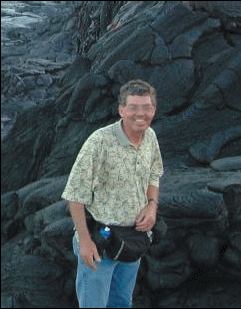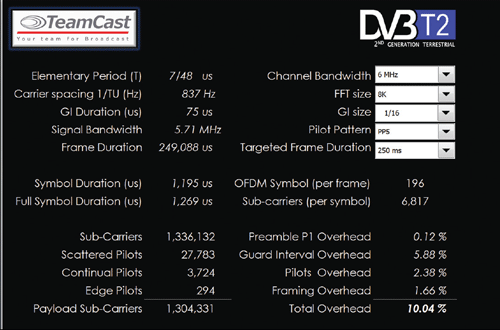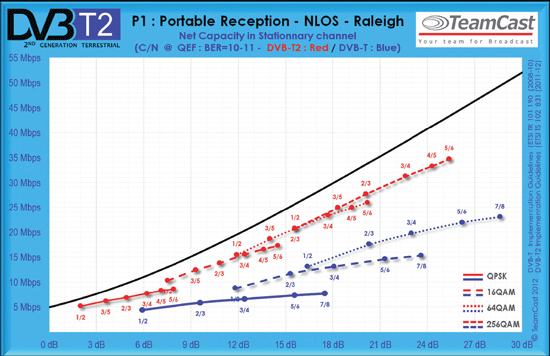
Doug Lung
In last month’s column I described the principles behind OFDM, how it is generated and received and different parameters that can be adjusted to optimize the transmission for different uses. This month I’ll examine how parameters can be modified for different tradeoffs between coverage, robustness and data rate. I’ll use a spreadsheet developed by Teamcast to show some of the options available for a 6 MHz U.S. TV channel using the DVB-T2 COFDM standard.
CHOICES, TRADE OFFS
The parameters I will consider are Fast Fourier Transfer (FFT) size, guard interval (cyclic prefix) and the pilot pattern. A channel bandwidth of 6 MHz is assumed and for maximum efficiency I’ll target a frame duration of 250 ms.
The FFT size is related to the number of carriers in the OFDM signal. All other parameters being the same, doubling the FFT size will halve the carrier spacing. As described last month, the symbol duration is the reciprocal of the carrier spacing so halving the carrier spacing will double the symbol duration.
Since the guard interval is applied to each symbol, doubling the symbol duration will reduce the impact of the guard interval on the data rate or allow increasing the guard interval to reject longer echoes without impacting data rate. This is an advantage in a single frequency network as transmitters can be spaced further apart without interfering with each other.

Fig. 1: DVB-T2 parameters and performance
The downside of the larger FFT is that as carrier spacing decreases, Doppler shift becomes more of a problem. The impact of Doppler shift is proportional to the carrier frequency, so VHF will be less impacted by it than UHF. Narrower channels (6 MHz in the United States versus 8 MHz in Europe) cram the carriers closer together, making the impact of Doppler worse.
Mike Simon of Sinclair Broadcast Group did an analysis of the impact of Doppler on different FFT sizes in a 6 MHz channel and found that at 600 MHz the Doppler shift became a problem over 95 mph with an 8K FFT and dropped to 47 mph with a 16K FFT. With 8 MHz of channel bandwidth, the speeds increase to 126 mph and 63 mph, respectively.
The professional video industry's #1 source for news, trends and product and tech information. Sign up below.
Another disadvantage of larger FFT sizes is that they are more complicated to demodulate, requiring more processing power and, thus, increase power consumption, a potential problem for handheld devices. For this month’s examples, I’ll use an 8K FFT, which will allow mobile reception.
The other parameter to consider is the guard interval. This will determine the maximum delay the receiver can tolerate. Note that, unlike VSB, with COFDM, echo rejection is set by the transmission parameters, not the receiver design. This makes it much easier to design a single frequency network or distributed transmission system.
Guard interval is usually expressed as a fraction of the symbol duration. A guard interval of 1/16 with an FFT of 16K in a 6 MHz bandwidth will have a duration of 149 ms. With an 8K FFT size, a guard interval of 1/8 will be needed to give the same duration. I’ll target a guard interval of 75 ms for the examples, which will handle echoes of the same length.

Fig. 2
To improve robustness, some data carriers are replaced with pilot carriers the receiver uses to perform channel estimation, equalization, common phase error correction and synchronization in a manner somewhat similar to the training signals in ATSC 8VSB.
The DVB-T2 standard specifies eight different scatter pilot patterns named PP1 through PP8. To find out which patterns to use in which applications, search online for EBU Technical Bulletin 3348, “Frequency and Network Planning Aspects of DVB-T2.”
Moving from PP1 to PP8, overhead decreases, but the carrier-to-noise (C/N) performance decreases. The variation in C/N is not huge, less than 2 dB according to Bulletin 3348, and in practice, well-designed receivers are likely to perform better. I’ll use the highest recommended pilot pattern, up to PP7, in the examples.
EXAMPLES
For the first example, let’s design a DVBT2 system to match the realistic C/N requirement for the current ATSC A/53 system. While 8VSB has an additive white Gaussian noise (AWGN) of 15 dB, in an environment with multipath, the required ATSC C/N rises rapidly.
The Teamcast DVB-T2 Multiple PLP Allocator spreadsheet provides DVB-T2 C/N values for AWGN, fixed reception (Ricean), portable reception (Rayleigh) and reception with a zero-dB echo.
With an FFT of 8K, a guard interval of 1/16 (75 microseconds), PP5 pilot pattern and a 249 ms frame length, using 64 QAM with appropriate coding, we can achieve a 23.9 Mbps average input data rate (compared to 19.39 Mbps for ATSC), an AWGN C/N of 15.1 dB and a worst-case 17.7 dB C/N in a portable use channel. The symbol duration is sufficient to allow mobile reception and multipath should not be an issue with a 75 microsecond guard band. Fig. 1 shows the DVB-T2 parameters used for these two examples.
We can trade off some of that data rate for a more robust signal with lower C/N for indoor and handheld reception. With the increased resolution of today’s tablets, we’ll want HD resolution. The ATSC mobile DTV standard uses H.264, so let’s use a bit rate of 6 Mbps and see how low we can get the C/N using DVB-T2.
The spreadsheet revealed that for the same FFT, guard interval and pilot pattern, with DVB-T2 we can transmit 6.3 Mbps using QPSK modulation and Long or 3/5 rate coding in a 6 MHz channel. The C/N requirement is only 2.3 dB AWGN, with a worst case of 3.6 dB using the portable channel model.
This C/N is better than the theoretical C/N for a quarter-rate A/153 mobile signal, which would be limited to a maximum data rate of less than 3 Mbps without using the “full-channel” extensions to A/153—not nearly enough to allow full-resolution HDTV. In field testing, the required C/N has been found to be significantly higher, around 7–9 dB, than the predicted C/N for A/153 quarter- rate coding, meaning the DVB-T2 data rate could be increased while maintaining performance as good or better than ATSC A/153.
These are just two examples of the performance improvements available with COFDM and DVB-T2, specifically. Request the spreadsheet from Teamcast and run your own studies. Note that with DVB-T2’s physical layer pipes (PLP) you can transmit multiple streams with different bit rates and C/N requirements simultaneously. Fig. 2 shows the data rate versus C/N for different COFDM carrier modulation and coding parameters in a portable environment (the most demanding) in relationship to the Shannon limit (black curve).
There are some trade-offs—COFDM has a higher peak-to-average power requirement, which means stations may need to upgrade transmitters or reduce power. What impact will that have on coverage? I’ll cover that next month in COFDM Basics Part 3.
Comments and questions are welcome. Email Doug atdlung@transmitter.com.

Doug Lung is one of America's foremost authorities on broadcast RF technology. As vice president of Broadcast Technology for NBCUniversal Local, H. Douglas Lung leads NBC and Telemundo-owned stations’ RF and transmission affairs, including microwave, radars, satellite uplinks, and FCC technical filings. Beginning his career in 1976 at KSCI in Los Angeles, Lung has nearly 50 years of experience in broadcast television engineering. Beginning in 1985, he led the engineering department for what was to become the Telemundo network and station group, assisting in the design, construction and installation of the company’s broadcast and cable facilities. Other projects include work on the launch of Hawaii’s first UHF TV station, the rollout and testing of the ATSC mobile-handheld standard, and software development related to the incentive auction TV spectrum repack. A longtime columnist for TV Technology, Doug is also a regular contributor to IEEE Broadcast Technology. He is the recipient of the 2023 NAB Television Engineering Award. He also received a Tech Leadership Award from TV Tech publisher Future plc in 2021 and is a member of the IEEE Broadcast Technology Society and the Society of Broadcast Engineers.
